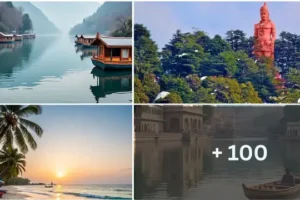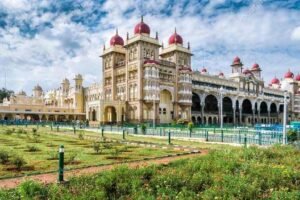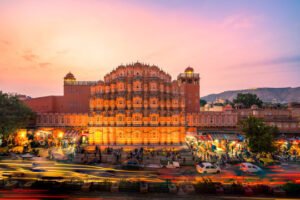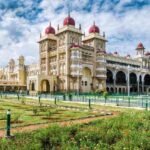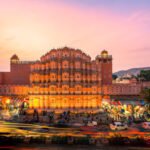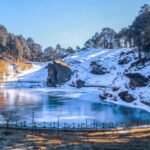Dzongsar Khyentse Rinpoche Institute, Most Popular Monastery in Bir, How to Reach 2025
Monastery of Dzongsar Khyentse Rinpoche Institute: A Sanctuary of Tibetan Buddhism: The Dzongsar Khyentse Rinpoche Institute stands as a beacon of Tibetan Buddhism, deeply rooted in the philosophies and traditions that have shaped the spiritual landscape of the Himalayas. Founded by Dzongsar Jamyang Khyentse Rinpoche, an eminent Bhutanese lama, filmmaker, and writer, the institute serves as a sanctuary for the preservation and dissemination of Buddhist teachings. Located in the serene landscapes of Bir, Himachal Pradesh, India, the monastery provides an ideal setting for contemplative practice and scholarly pursuits.

The inception of the Dzongsar Khyentse Rinpoche Institute was driven by a mission to nurture a holistic understanding of Buddhism. It aims to bridge the gap between ancient wisdom and contemporary life by offering a comprehensive curriculum that includes traditional scriptural studies, meditation practices, and modern subjects. This educational approach ensures that students are well-equipped to apply Buddhist principles to everyday challenges and to propagate these teachings globally.
Furthermore, the institute holds a significant place in the realm of Tibetan Buddhism due to its commitment to upholding the non-sectarian spirit of the Rimé movement. This movement, which emerged in the 19th century, emphasizes the importance of studying and practicing teachings across different Buddhist schools. By fostering inclusivity and mutual respect among diverse Buddhist traditions, the Dzongsar Khyentse Rinpoche Institute plays a vital role in promoting harmony and understanding within the Buddhist community.
In essence, the Dzongsar Khyentse Rinpoche Institute is not merely an educational institution but a sanctuary where the sacred and the scholastic converge. It is a place where the timeless teachings of the Buddha are preserved, practiced, and propagated, ensuring that their profound wisdom continues to inspire and guide future generations. As we delve deeper into the various aspects of this remarkable monastery, we will uncover the richness of its contributions to the spiritual and intellectual landscape of Tibetan Buddhism.
Historical Background and Founding
The Dzongsar Khyentse Rinpoche Institute, a cornerstone of Tibetan Buddhism, was founded by Dzongsar Khyentse Rinpoche, a revered lama known for his efforts in preserving and promoting Buddhist teachings. Born in 1961 in eastern Tibet, Dzongsar Khyentse Rinpoche, also known as Khyentse Norbu, is a lineage holder in the Rime, or non-sectarian, movement of Tibetan Buddhism. His lineage traces back to Jamyang Khyentse Wangpo and Jamyang Khyentse Chökyi Lodrö, influential figures dedicated to the preservation of various traditions within Tibetan Buddhism.
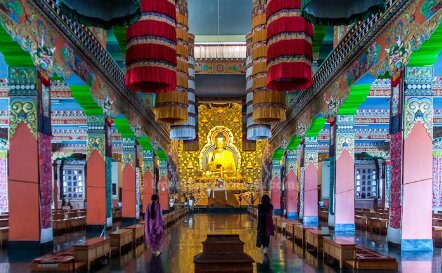
Dzongsar Khyentse Rinpoche founded the institute in 1980 in Bir, Himachal Pradesh, India, as a response to the cultural and spiritual upheavals faced by the Tibetan community following the Chinese invasion of Tibet. The institute aimed to preserve Tibetan Buddhist teachings and provide a sanctuary for monastic education. Its establishment marked a significant milestone in the preservation of Tibetan culture and religion amidst the diaspora.
Over the years, the Dzongsar Khyentse Rinpoche Institute has grown significantly, becoming a prominent center for Buddhist studies and practice. One key milestone in its development was the construction of a new temple complex in 1992, which provided enhanced facilities for both monastics and lay practitioners. Another significant event was the introduction of a rigorous academic curriculum that includes traditional Buddhist philosophy, logic, and debate, alongside modern subjects such as science and English, reflecting Rinpoche’s vision of integrating ancient wisdom with contemporary knowledge.
The institute has also been instrumental in organizing various cultural and religious events, such as annual teachings and initiations by prominent lamas, which attract devotees and scholars from around the world. These events have not only enriched the spiritual lives of participants but also contributed to the global dissemination of Tibetan Buddhist teachings.
Today, the Dzongsar Khyentse Rinpoche Institute stands as a testament to the resilience and adaptability of Tibetan Buddhism. It continues to thrive as a beacon of spiritual learning and cultural preservation, embodying the vision and dedication of its founder, Dzongsar Khyentse Rinpoche.
Architectural Marvels of the Monastery
The Monastery of Dzongsar Khyentse Rinpoche Institute stands as a beacon of traditional Tibetan architecture, embodying centuries of cultural and spiritual heritage. Its architectural design is a harmonious blend of intricate artistry and functional spirituality. The monastery’s layout is meticulously planned to reflect the principles of Tibetan Buddhism, offering a sanctuary for meditation, learning, and communal living.
At the heart of the monastery lies the main temple, an awe-inspiring structure that captures the essence of Tibetan religious architecture. The temple’s facade is adorned with vivid murals and intricate carvings, depicting various deities, mandalas, and scenes from Buddhist lore. The interior is equally captivating, featuring a grand hall where a magnificent statue of Buddha presides, surrounded by a plethora of thangkas and ritual objects that enhance the spiritual ambiance.
The meditation halls, known as gompas, are strategically positioned within the monastery compound. These halls are designed to provide a serene environment for deep contemplation and practice. Each gompa is embellished with traditional Tibetan motifs, including the auspicious symbols and vibrant wall paintings that depict the life of Buddha and other spiritual narratives. The tranquil setting, combined with the hall’s acoustics, creates an ideal atmosphere for meditative practices and teachings.
Residential quarters for monks and students are thoughtfully integrated into the monastery’s layout, providing comfortable and functional living spaces. These quarters are designed with simplicity in mind, reflecting the monastic values of minimalism and humility. Despite their modest appearance, the rooms are equipped with all necessary amenities to support the daily lives of the monastic community.
Among the notable artistic and cultural artifacts housed within the monastery are ancient scriptures, rare manuscripts, and exquisite statues. These artifacts not only serve as objects of reverence but also as educational tools for students and visitors. The monastery’s library is a treasure trove of Buddhist literature, offering an extensive collection of texts that span various schools of Tibetan Buddhism.
Daily Life at the Monastery
The daily life at the Dzongsar Khyentse Rinpoche Institute is a harmonious blend of spiritual practice, education, and community service. The day for the monks, students, and residents typically begins before dawn, with the sound of the gong signaling the start of the morning meditation session. This period of silent reflection is crucial for grounding oneself and cultivating inner peace, setting a serene tone for the rest of the day.
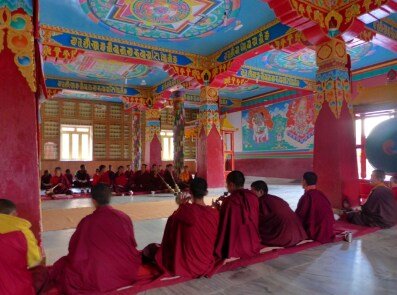
Following meditation, the community gathers for a communal breakfast, which is often a simple yet nourishing meal. The sense of unity and shared purpose is palpable during these meals, fostering a strong sense of belonging among the residents. After breakfast, the monks and students attend teachings and classes, where they delve into the intricate philosophies of Tibetan Buddhism, study sacred texts, and engage in debates to deepen their understanding.
One of the most revered aspects of life at the monastery is the ritual practices. These rituals, which may include chanting, prostrations, and offerings, are performed with great devotion and meticulous care. They serve as a means to purify the mind and accumulate merit, essential components of the Buddhist path. Additionally, the monastery places a strong emphasis on community service, with residents participating in various initiatives aimed at supporting local communities and preserving Tibetan culture.
As the day progresses, residents have time for personal study, meditation, or community activities. The evening often includes another session of meditation or a dharma talk, where a senior monk or teacher imparts wisdom and guidance. According to Tenzin, a long-term resident, “Living here is a constant reminder of the importance of mindfulness and compassion in every action we take.”
In this sacred space, the rhythm of daily life is not just about routine but about cultivating a deeper connection to oneself and others, embodying the core teachings of Tibetan Buddhism in every aspect of life. The monastery stands as a testament to the enduring power of spiritual practice and community, offering a sanctuary for those seeking enlightenment and peace.
Spiritual Activities and Ceremonies
At the Monastery of Dzongsar Khyentse Rinpoche Institute, spiritual activities and ceremonies form the cornerstone of daily life, reflecting the profound essence of Tibetan Buddhism. Regular practices such as pujas, or ritual offerings, are integral to the monastery’s spiritual rhythm. These ceremonies, often conducted in the early morning hours, involve intricate chants, prayers, and offerings to deities, aimed at generating merit and purifying negativities. The significance of pujas lies in their ability to create a sacred atmosphere that fosters spiritual growth and communal harmony among the monks and lay practitioners.
Meditation retreats are another vital aspect of the monastery’s spiritual activities. These retreats, often spanning several days or even months, provide participants with the opportunity to deepen their meditation practice under the guidance of experienced teachers. The serene environment of the monastery, coupled with structured meditation sessions, helps practitioners cultivate mindfulness, compassion, and inner peace. For many, these retreats are transformative, offering profound insights and a renewed sense of purpose.
In addition to daily practices, the monastery hosts several special annual festivals that draw participants from near and far. These festivals, such as Losar (Tibetan New Year) and the annual Guru Rinpoche Day, are marked by vibrant ceremonies, traditional dances, and elaborate rituals. They serve not only as a means of honoring important Buddhist figures and events but also as communal gatherings that strengthen cultural and spiritual bonds within the Tibetan Buddhist community.
The impact of these spiritual activities on participants and the broader community is significant. For those who partake, the practices offer a pathway to personal spiritual development and a deeper connection to Tibetan Buddhist teachings. For the broader community, the monastery’s activities foster a sense of unity, cultural preservation, and spiritual enrichment. In essence, the spiritual activities and ceremonies at the Monastery of Dzongsar Khyentse Rinpoche Institute are a testament to the enduring vitality of Tibetan Buddhism and its profound influence on the lives of those it touches.
Community Outreach and Global Influence
The Monastery of Dzongsar Khyentse Rinpoche Institute has consistently demonstrated a profound commitment to community outreach and global influence. Rooted in the principles of Tibetan Buddhism, the monastery actively engages in programs designed to uplift and support local communities. These initiatives encompass a wide range of activities, including educational workshops, healthcare services, and cultural preservation efforts. By addressing the immediate needs of the surrounding populations, the monastery not only fosters a sense of solidarity but also helps to sustain the rich cultural heritage of the region.
Educational exchanges form a cornerstone of the monastery’s outreach strategy. By facilitating the exchange of knowledge between scholars, practitioners, and students from various parts of the world, the monastery acts as a bridge between diverse cultures and traditions. These exchanges often include lectures, seminars, and collaborative research projects, which contribute to a deeper understanding and appreciation of Tibetan Buddhism on a global scale. The monastery also offers scholarships and grants to deserving students, thereby creating opportunities for individuals to pursue advanced studies in Buddhist philosophy and practice.
The Monastery of Dzongsar Khyentse Rinpoche Institute is an active participant in international Buddhist networks. Through these affiliations, the monastery collaborates with other institutions and notable figures in the Buddhist world to promote peace, compassion, and wisdom. One of the key aspects of these collaborations is the organization of international conferences and retreats, which serve as platforms for dialogue and mutual learning. These events attract participants from across the globe, fostering a sense of global Buddhist community and shared purpose.
Additionally, the monastery has established partnerships with several renowned institutions and scholars. These collaborations have led to joint research initiatives, publication of scholarly works, and the development of educational programs that benefit both the monastery and the wider Buddhist community. By leveraging these partnerships, the monastery amplifies its influence and contributes to the global dissemination of Tibetan Buddhist teachings and practices.
How to Reach Dzongsar Khyentse Rinpoche Institute
For those interested in visiting the Dzongsar Khyentse Rinpoche Institute, preparation and knowledge are key to a fulfilling experience. Located in the serene regions of Bir, Himachal Pradesh, India, the monastery offers a tranquil retreat into Tibetan Buddhism. To reach the institute, visitors can fly into Kangra Airport, approximately 68 kilometers away, or take a train to Pathankot, which is around 140 kilometers distant. From either point, taxis and local buses provide convenient transport to the institute.
Accommodation options are readily available, ranging from the institute’s guest quarters to nearby hotels and homestays in Bir. Prior booking is advisable, particularly during peak seasons or special events. The institute itself offers a range of rooms to suit different preferences and budgets, ensuring a comfortable stay for all visitors.
Upon arrival, visitors are encouraged to adhere to the monastery’s guidelines. Respectful attire is required, with an emphasis on modesty. Photography may be restricted in certain areas, particularly during ceremonies. Participation in daily activities such as meditation sessions and teachings is generally welcomed, but it is essential to seek permission and follow the schedule provided by the institute.
Special considerations should be made for those wishing to engage deeply with the monastery’s offerings. For example, participating in ceremonies or intensive retreats may require pre-registration or special permits. It is advisable to contact the institute in advance to understand any specific requirements or restrictions.
To make the most of your visit, immerse yourself in the tranquil environment and the rich spiritual teachings available. Engage with the resident monks and scholars to gain a deeper understanding of Tibetan Buddhism. The peaceful atmosphere, combined with the profound wisdom shared at the Dzongsar Khyentse Rinpoche Institute, promises a unique and enriching experience.
What are Dzongsar Khyentse Rinpoche teachings?
This teaching is recommended for those who wish to explore Buddhist Tantra. Rinpoche will teach on “Sadhana in Vajrayana” every day.
Who is the founder of Deer Park Institute?
The founder of Deer Park Institute H.E. Dzongsar Jamyang Khyentse Rinpoche, named the Institute-Deer Park.
Where is Dzongsar Khyentse Rinpoche Institute?
Located in the serene regions of Bir, Himachal Pradesh, India, the monastery offers a tranquil retreat into Tibetan Buddhism.
When does the construction of Dzongsar Khyentse Rinpoche Institute started?
In the March of 2000, construction works were started and by the end of 2004, the Shedra was shifted from Bir to Chauntra.
Who inaugurated Dzongsar Khyentse Rinpoche Institute?
The opening ceremony was graced by HH the Dalai Lama. Again in 2008, The Sakya Trizin consecrated the Shedra and gave Path and Fruit teachings.
When was Shedra shifted to Bir?
The Shedra was shifted to Bir, in Himachal Pradesh, in 1985.
Who founded Dzongsar Khyentse Rinpoche Institute?
In 1982, Dzongsar Khyentse Rinpoche established Dzongsar Institute, a small monastery in Sikkim, India, with about 40 monks.
Who started Dzongsar Khyentse Rinpoche Institute in Himachal?
Shedra started Dzongsar Khyentse Rinpoche Institute in Bir in 1985 with at least 15 years old ordained students.
When was Dzongsar Khyentse Rinpoche Institute shifted to Chauntra?
After teaching in Bir for about 13 years, the Shedra was shifted to Chauntra after buying the land in 1999 and construction complete in 2004 and inauguration in 2008 by HH the Dalai Lama. The Sakya Trizin consecrated the Shedra and gave Path and Fruit teachings.
